Garden Rose Tips and Tricks (Everything You Need To Know Before Planting Your Garden Rose)
A timeless, lovely garden rose is one of the absolute most beautiful flowers you could add to your garden. Garden roses are so special that once you plant one, you’re sure to want another and another!
I am often asked about the garden rose varieties in my own garden, as well as tips on how to plant and care for them. So here are some helpful garden rose tips for planting, care, and choosing the perfect rose bush variety for your own garden (even if you’re a beginner!).
Let’s dive into the details!
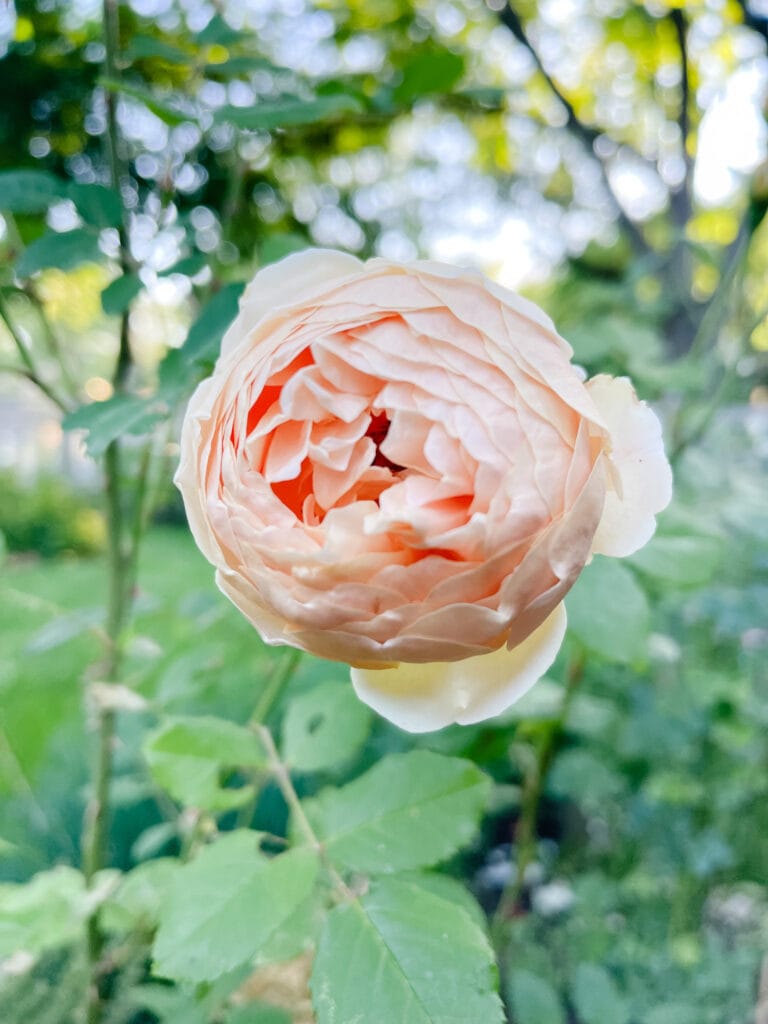
*Disclosure: This post may contain affiliate links. All opinions and recommendations are my own.
What Is A Garden Rose? (And Why You’ll Love Them)
The easiest way to explain the answer to “what is a garden rose?” is to first describe what it is not. When you think of a typical red rose sold at every grocery store and standard flower shop, this is not a garden rose. These typical red roses are actually a commercially-grown Modern Rose.
Did you know that there are actually three main categories of roses? Modern Roses, Wild Roses, and Garden Roses. The modern roses (grocery store rose) have been bred for a prolonged vase life, have a very “uniform” shape and look, and generally carry zero fragrance. So if you ever heard someone say they don’t care for roses, they’re most certainly talking about the lackluster supermarket find.
However, garden roses are quite the opposite. Garden roses were bred to showcase their beauty in the garden. And when I say garden roses are stunning, they truly are!
Every stem on the same garden rose shrub is a bit different- from a warmer pink shade on one bloom to a lighter, creamier pink shade on a few ruffles of another bloom. If you cut a bunch of stems from the same garden rose bush, the variation in color of the blooms or the shape and form of the outer petal ruffles may be slightly different.
These characteristics make garden roses romantic, beautiful, timeless and full of charm. It’s no wonder garden roses are a classic staple in European gardens. When you hear someone refer to an “English Rose” they’re most certainly referring to a lovely garden rose.

And if their beauty wasn’t enough, garden roses have the most heavenly scent! When you hear the term “aromatherapy”, garden roses are a true example of this- taking in the fragrance of a garden rose can really melt your troubles away (at least for the moment!).
Gardening, and especially growing roses, is so good for your mental health, so planting and caring for a beautifully fragrant garden rose really enhances the senses and brings a sense of calm. (A win-win!)
Some garden roses boast a fruity scent like raspberries, or a citrus scent like lemon, others an “old world rose” strong floral scent, and some will be deliciously sweet! And not only do these roses smell fantastic in the garden, they retain their fragrance once cut, so you’re able to enjoy their lovely scent throughout your home for days!
Choosing A Location For Your Garden Rose
First and foremost, it’s important to consider: “where would I like to have garden roses growing in my garden?”.
The reason this is important is because different varieties of rose bushes have varying growth habits- one variety may be more compact, where the other may be a climbing rose, reaching 15 feet tall- perfect for a pergola! Some roses tolerate a bit more shade, where other rose varieties truly do require full sun, at least 6-8 hours per day.
So the first step is to figure out where you’d love to see a rose in your garden, do a little homework to find the right rose variety, and go from there.
Garden Rose Characteristics To Consider
If you are a beginner rose gardener, and not quite the rosarian just yet, don’t get too caught up on all these details, but rather use as a guide for deciding which garden rose variety might be a perfect fit for you! These are some garden rose characteristics to consider:
- Rose Type: (Floribunda vs Hybrid Tea vs Climbing Rose, etc.)
- Color: (Can vary from White, Cream, Light Pink, Bright Pink, Peach/Apricot, Soft Yellow, etc.)
- Hardiness: (USDA Zones 4-10; always check the specific rose variety for zone hardiness. Very few varieties are suited for Zones 2 or 3)
- Flowering: (Repeat/Continual Blooming/Once Blooming, etc.)
- Bloom Size: (Small, Medium, Large)
- Bloom Form: (Cupped, Clustered, Double, Full, Single, Flat, Quartered, Semi-Double, etc.)
- Fragrance: (Lightly Fragrant – Exceptionally Fragrant; As well as specific fragrance: hints of Lemon/Champagne/Raspberry/Sweet Rose/Apple, etc.)
- Foliage: (ex: Bright, Glossy Green)
- Size: (ex: Floribunda/Small Shrub vs Climbing Rose/Large Climber)
- Growth Type: (Bushy, Upright vs. Landscape Rose, etc.)
- Height: (4-5ft tall vs a 20ft climber)
- Width: (2-4ft wide, etc.)
- Light Preference: (Full Sun, 6-8 hours vs can tolerate shade)
- Soil Preference: (Generally all prefer well-draining soil, rich in organic matter)
- Water Preference: (ex: medium water requirement)
- Disease Resistance: (Excellent disease resistance vs prone to black spot, etc.)
- Petal Count: (ex: 75-90)
- Spacing: (typically 2′-4′)
- Characteristics: (Great for cutting, good for growing in pots, good for a rose hedge, etc.)
Garden Rose Design Ideas
FORMAL GARDENS AND COTTAGE GARDENS
Garden roses are so versatile that they can be seen in formal and cottage gardens alike. For a formal garden, consider a hedge, or fill beautiful garden roses in the center of a boxwood parterre (lovely!).
For a more natural, cottage garden style, consider planting garden roses with other free flowing perennials for a romantic and calm garden setting.
I also love seeing garden roses that peek through slats in a fence!
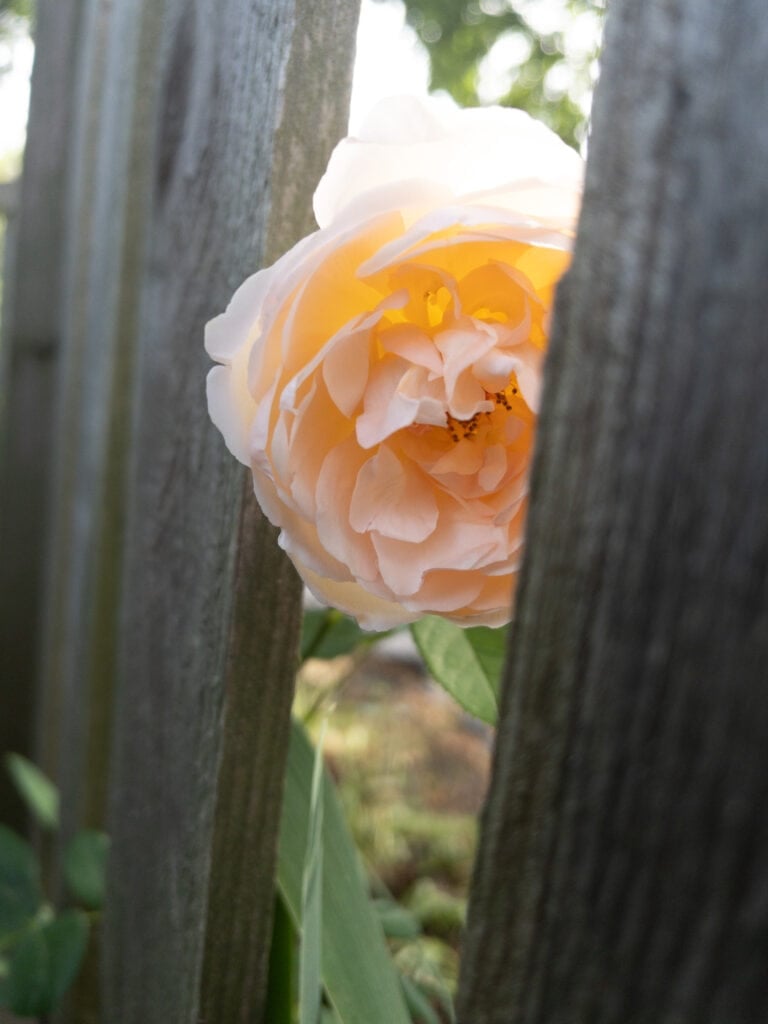
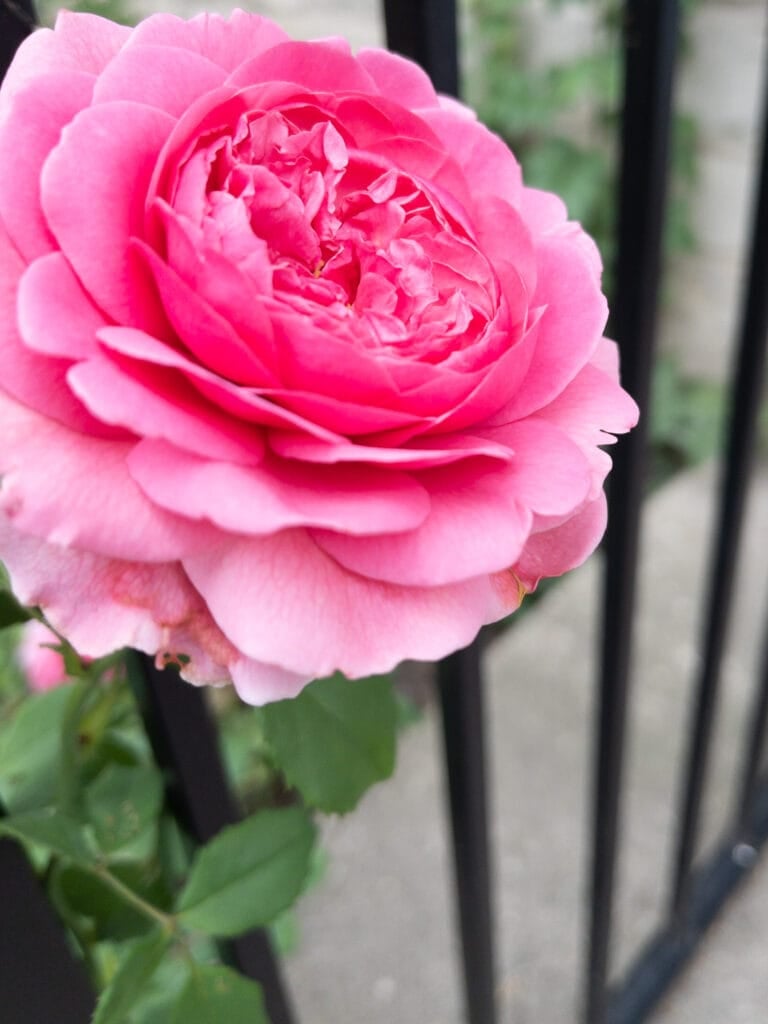
And what is more romantic that an elegant climbing rose that grows up a trellis or over a front door?
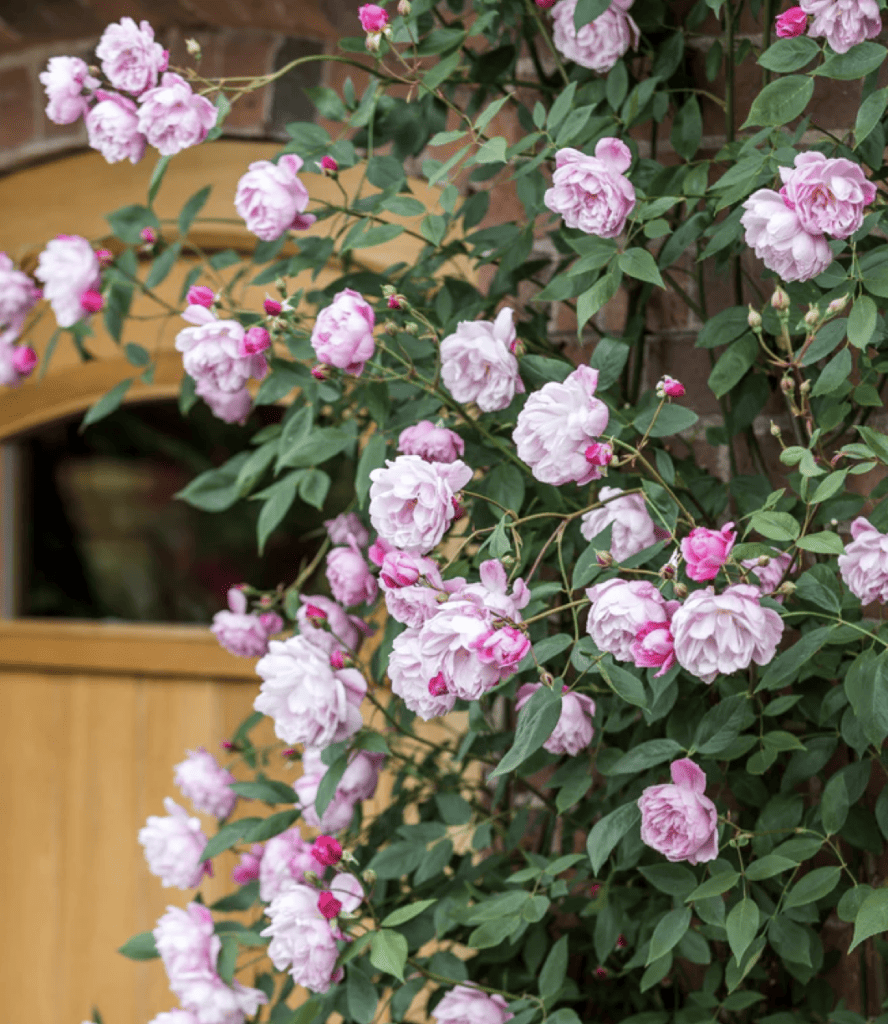
We have a rose garden in our front yard that tends to lean a bit more toward a cottage garden style, with beautiful peach garden roses and pink garden roses and both light and bold purple flowers throughout- and many pollinator-friendly flowers as well! It’s my happy place in the garden 🙂
Rose Garden
Consider creating a gorgeous “rose garden”. Choose a few rose varieties for beauty in the garden or for highly fragrant cut flowers!
*If you love, love, love pink garden roses as much as I do, be sure to read: 20 Most Beautiful Pink English Roses For Your Garden
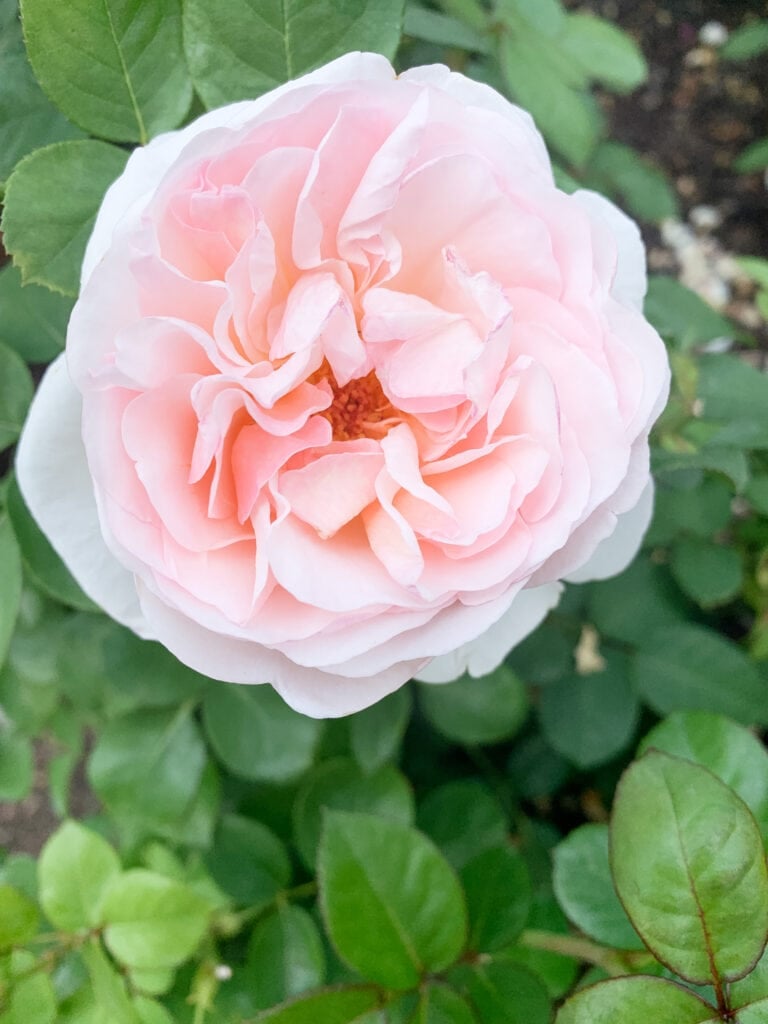
Garden Rose HEDGE Or Border
Consider planting a rose hedge behind a boxwood hedge, for gorgeous year-round interest. The bold glossy leaves of the boxwood (that typically grow 24-48 inches tall) would really showcase the stunning garden roses flowing above.
Tip: I love using boxwood as a more “structured” plant in the garden, as it provides year round interest, is such a timeless and elegant garden shrub, and it protects kids/pets from any rose thorns!
Old fashioned English roses create a lovely herbaceous border! (Keep reading for some fantastic garden rose companion flowers!)
Growing Garden Roses In Pots
Many people assume that you need to grow garden roses in the garden, but actually some do quite well growing in pots! You would want to choose a variety that doesn’t get too large. Climbers and ramblers get too big for containers, but hybrid tea and smaller floribunda roses are great for growing in pots.
So even if you don’t have room for a garden, or are limited to a balcony, you’ll still be able to enjoy these gorgeous flowers.
And be sure to plant your rose bush in a terracotta planter, as terracotta allows the plant to breathe and absorb water, whereas plastic pots get very hot and can scorch the rose roots.
Garden Rose COMPANION PLANTS
Since garden roses tend to have glossy green foliage with lush blooms, they have a classic look that compliments so many shrubs and flowers! From evergreen shrubs like boxwood, to flowers that are deep purple to creamy white, roses create a perfect backdrop for a versatile color palette in the garden.
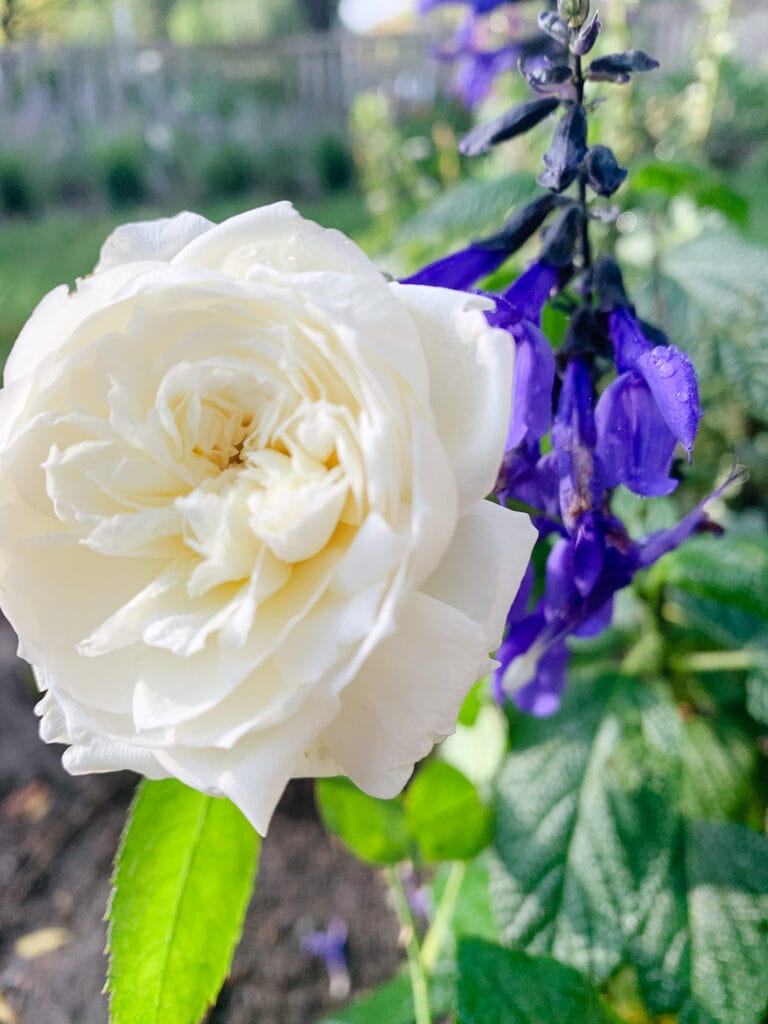
For example, my favorite color combination with soft pink garden roses are touches of purple, light lilac, white, or even brighter pinks!
- Boxwood (evergreen shrub with stunning glossy green foliage)
- Other varieties of Beautiful Pink English Roses (for a cottage garden, formal garden or rose garden)
- Russian Sage (wispy lilac blooms that bloom all summer long into fall, and attract the best pollinators!)
- Endless Summer Hydrangeas or Nantucket Blue Hydrangeas (light blue florets on puff ball clouds of blooms. *Soil amendments may be needed to achieve the blue color!)
- Montrose White Calamint (for a pollinator-magnet, wispy, ethereal white perennial)
- Black And Bloom Salvia (for a pollinator-friendly, bold deep blue/violet annual)
- Any of these 12 Beautiful Purple Flowers For Your Summer Garden !
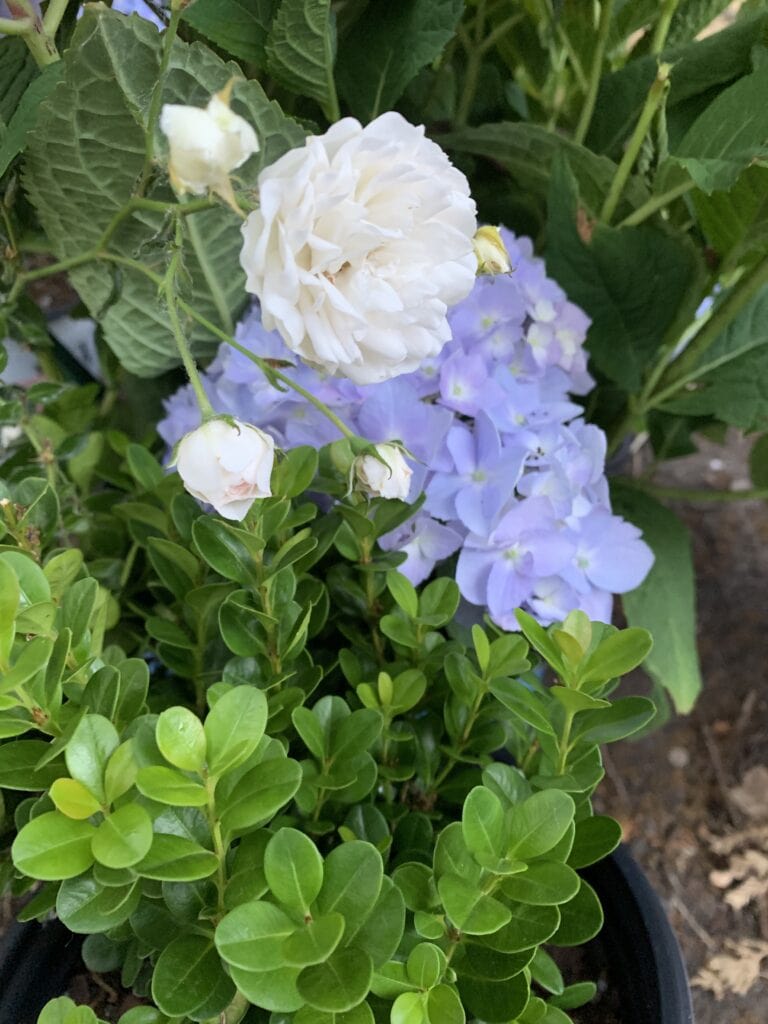
Planting Garden Roses
If you’ve ever been lucky enough to receive a garden rose bouquet as a gift, or if you’ve spotted a garden rose growing in someone’s garden, you were probably immediately drawn to its beauty and charm. And of course, now, you’re interested in growing your own! It’s no wonder why once you start growing garden roses, there’s no going back!
Here are some tips and tricks for planting garden roses successfully in your own garden:
WHERE TO PLANT
- Plant your garden rose in moist, well-drained soil (roses do not tolerate standing water or soggy soil), that is rich in organic matter
- An ideal location will receive at least 6-8 hours of direct sunlight (more sun will typically allow for more blooms!)
- (Note: Few rose varieties can tolerate shade, for example the Zéphirine Drouhin or Seafoam Roses do quite well with shade)
- Space about 3 feet from other larger plants, to allow for proper air circulation
WHEN TO PLANT
- Garden roses can be planted year-round, as long as the ground is not frozen, but the ideal time is in the Spring, and more often than not, you’ll only be able to find these roses available in the Spring (plus they tend to sell out during the Summer- the best garden roses always do!)
- Fall and early Spring are generally the preferred planting times (to avoid the extreme heat of summer as the plant gets established)
- NOTE: Because garden roses are a hot commodity, be sure to place online orders well in advance! I’ll link some suggested online garden rose retailers at the end of this post
HOW TO PLANT
- Dig a hole slightly wider and deeper than the root ball of the rose plant. (This will allow ample space for the roots to spread and grow)
- Make sure the hole is deep enough so that the bud union, which is the swollen area where the rose was grafted onto the rootstock, sits at ground level or slightly above
- Loosen soil around the hole
- (I like to mix into the soil a handful or 2 of organic compost- I use cotton burr compost, as well as a handful of organic rose fertilizer)
- Remove the plant from the garden nursery container
- Gently tease some of the roots at the bottom and sides, if established
- Place the rose shrub in the hole with the crown/graft point at soil level
- Backfill the hole with soil
- Mound up soil to the base to keep water from pooling
- Pat the soil down with your hands
- Water the soil around the shrub
(NOTE: See above section on growing garden roses in pots!)
Proper Rose Care & Cutting
WATERING
- During the first planting year, keep soil evenly moist but not soggy (water daily in extreme heat, or every other day)
- During the second year, continue to water regularly if rainfall isn’t sufficient
- Water more frequently during extreme heat
- Water more frequently if growing roses in planters/pots/containers
- Water around the base of the shrub, not directly on the foliage
MULCHING AND FERTILIZING
- From the 2nd year onward, in early Spring prepare to fertilize
- If you have a layer of mulch already surrounding your rose, move some of it off to the side to expose the soil
- Fertilize by adding a few handfuls of Rose-Tone, or similar, to the top layer of soil in early Spring to promote foliage growth
- Add 1-2 inches of mulch around the base of the plant to help retain moisture, keep the roots cool, and keep nearby weeds at bay
- Repeat every 2-4 weeks throughout the growing season
- By Fall, it’s optional to add a bone-meal to the soil for extra plant health for the next season
- Note: I highly encourage using an organic fertilizer, especially if you choose to do so during plating, as a more chemical-filled fertilizer can burn the root system of your garden rose
PRUNING & CUTTING ROSES
- When pruning or cutting roses, be sure to wear protective rose garden gloves to protect from thorns
- When cutting roses, always cut on a 45 degree angle and above a stem that has five leaves– this will ensure more flowers will grow back from the cutoff section. And the angled cut will help ensure water will pool off the cut, vs pooling on top (imagine the angled cut is like a little water slide 😉 )
- (Optional- there are “pruning sealers” that you can use that actually seal the cut so your rose is less susceptible to disease)
- When pruning roses, remember the “3 D’s”= “Dead, Diseased, Damaged”. This rule is always applicable. You want to remove any dead, diseased or damaged leaves immediately. If you have leaves still remaining in winter, you may want to remove those as well.
- Once you’ve finished pruning, be sure to clean up and dispose of any pruned material properly. (Removing and discarding these clippings helps eliminate potential disease sources and reduces the risk of pests finding a home in your garden)
- The best time to prune is late winter and early spring
- Try to avoid stronger pruning in late fall and early winter
- If you encounter any discoloration in your stems/canes, cut below the discoloration
- Place your cut garden roses in water as soon as possible (and remove leaves that are submerged in water)
- ** For more detailed tips on cut flowers, be sure to check out: Simple Flower Arranging Tips From A Pro Floral Designer
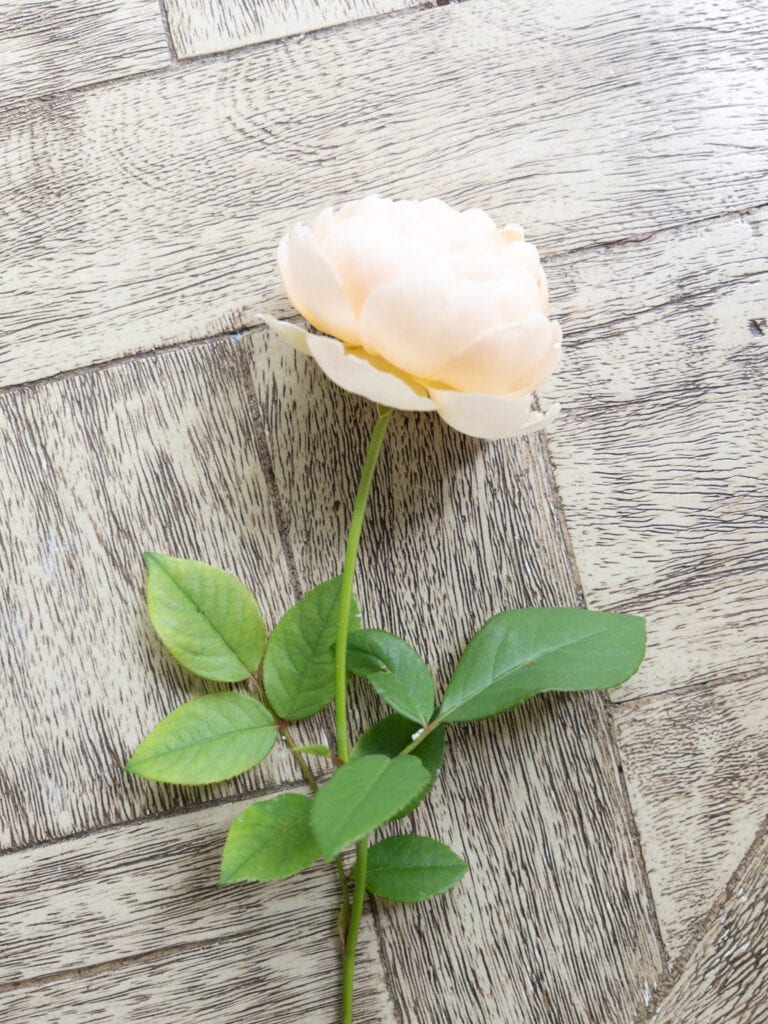
Where To Buy Garden Roses
When buying most English roses / garden roses, they tend to be available in either a bare root or a potted rose bush. Here are a few of my favorite sources for buying garden roses:
- Heirloom Roses
- Grace Rose Farm
- David Austin Roses
- Local garden nurseries
- (You could also try calling local landscaping companies who might have access to rose bushes!)
HELPFUL ITEMS FOR Garden Rose Care:
*Swiss Made Steel
*Highest Quality
*One-Hand Garden Pruners
*Arm To Catch Cut Rose (so you don't need to reach into a thorny rose bush!)
Happy Planting!
Other Posts You’ll Love:
20 Most Beautiful Pink English Roses For Your Garden
3 Beautiful White Garden Roses Every Gardener Will Love
22 Beautiful Coffee Table Books Inspired By The Garden
3 Best Flowers For Pollinators
The Most Beautiful Yellow Tulips: Avant Garde Tulips










